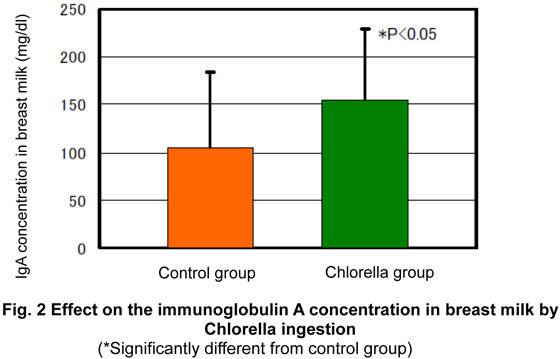- TOP
- List of reports
- Chlorella (Chlorella pyrenoidosa) supplementation decreases dioxin concentration and increases
immunoglobulin-A concentration in breast milk
Chlorella (Chlorella pyrenoidosa) supplementation decreases dioxin concentration and increases immunoglobulin-A concentration in breast milk
【Scientific information】
Research and Development Department, Sun Chlorella Corporation
Chlorella (Chlorella pyrenoidosa) supplementation decreases dioxin concentration and increases immunoglobulin-A concentration in breast milk
Featured in The Journal of Medicinal Food, 2007
A clinical study of pregnant women conducted at Saiseikai Nara Hospital in Nara City has confirmed that the dioxin concentration in breast milk of parturient mothers ingested Chlorella during pregnancy decreased, and on the other hand, increased the immunoglobulin A concentration.
- Breast milk and dioxin
- Breast milk is not only nutritionally important to infants; it also contains a variety of components related to the biodefense mechanisms of infants such as immunoglobulin A, lactoferrin, and lysozyme. The immunoglobulin A contains in breast milk, in particular, works on the intestinal tract of infants, the immune functions of which are still largely undeveloped, to help their body become resistant to bacterial and viral infections. However, high dioxin concentration has been detected in breast milk, triggering concerns regarding possible impacts on the health of infants ingesting breast milk. The pros and cons of raising babies with breast milk has thus become an important social issue in Japan.
- Study Objectives
- Pregnant women living in Japan participated in the clinical study, which aimed at investigating the possible effects of Chlorella ingestion on the dioxin concentration and immunoglobulin A in breast milk.
- Method of experiments
- Breast milk and maternal blood samples were provided by 35 parturient mothers, and dioxin 28 isomers were measured to investigate transfer of dioxin via breast milk from the mothers to infants. 18 of the 35 mothers were asked to ingest 30 tablets of Chlorella each day starting at the 12th to 16th week of gestation until around 6 months before childbirth. We then compared their dioxin concentration and immunoglobulin A in breast milk with those in the control group (whom did not ingest Chlorella). This study was carried out in compliance with the Helsinki Declaration, along with approval from the Institutional Review Board of Saiseikai Nara Hospital.
- Results
- (1) Chlorella reduced the concentration of dioxin in breast milk
- Compare to the control group, the Chlorella group showed a significant decrease of dioxin concentration in breast milk. This indicates that, if the mothers take Chlorella into their dietary habit during pregnancy, there is a possibility of decreasing the transition of dioxin to the infants via the breast milk(Fig. 1).
- (2) Chlorella increased the concentration of immunoglobulin A in breast milk
- Compare to the control group, the Chlorella group showed a significant increase of immunoglobulin A concentration. The increase of immunoglobulin A in breast milk is expected to be effective against the reduction in risk of infant infections (Fig. 2).
- The results of this study suggest that from taking Chlorella into the dietary habit, the dioxin concentration decreases and on the other hand, increases the immunoglobulin A concentration in breast milk which indicate beneficial effects on the infants. Also no side effects were confirmed from the mothers ingested Chlorella.


Paper cited
- Journal cited:
- The Journal of Medicinal Food, Vol. 10 No. 1, pages 134-142, 2007.
- Title:
- Chlorella (Chlorella pyrenoidosa) supplementation decreases dioxin and increases immunoglobulin A concentration in breast milk
- Authors:
- Shiro Nakano 1), Hideo Takekoshi 2), 3), Masuo Nakano 2), 3), 4)
- Affiliation:
- 1) Saiseikai Nara Hospital, 2) Bio-Resource Science Course, Obihiro University of Agriculture and Veterinary Medicine Graduate School, 3) Hokkaido Medical Plant Research Institute, 4) Rakuno Gakuen University





